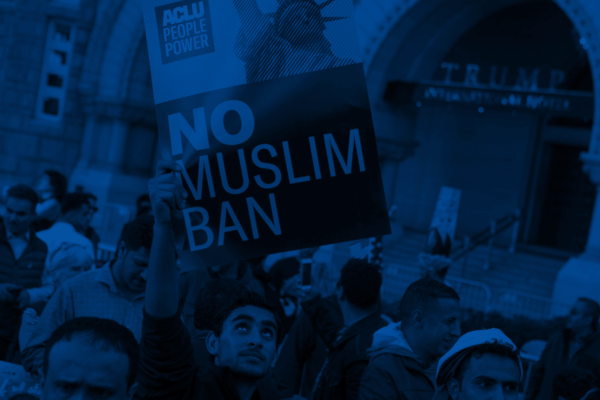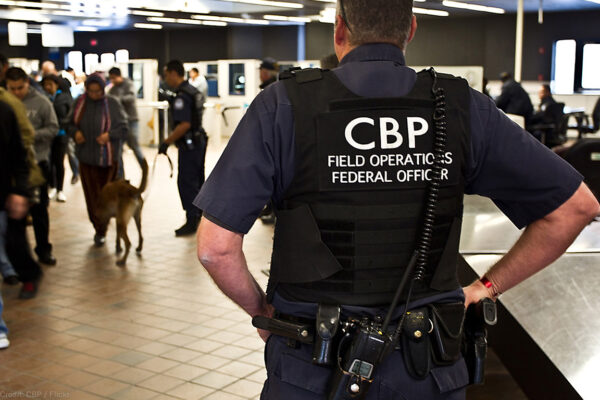Two years ago, in April 2017, the American Civil Liberties Union of Florida and other ACLU affiliates around the country filed lawsuits to compel U.S. Customs and Border Protection (CBP)’s compliance with our Freedom of Information Act requests for records related to President Trump’s Muslim travel ban.
Specifically, we asked for documents regarding the agency’s implementation of the ban at airports and seaports in our state. Nearly two years later, having overcome various attempts by the government to pigeonhole and delay these efforts, and having reviewed thousands of heavily redacted documents released as a result, here is what we found.
Chaos
By all accounts, the field execution of the Jan. 27, 2017 executive order (EO) banning the entry of nationals from several Muslim-majority countries was chaotic nationwide. CBP’s assistant director for border security in Florida, in an email to staff on Feb. 3, 2017, put it in the same category as an “active shooter” incident earlier that year— apparently referring to a shooting at the Fort Lauderdale-Hollywood International Airport, where five people had been killed. An assistant port director at the Miami International Airport described the week after the EO’s unveiling as “beyond hectic.” Others referred to a “roller coaster” unlike anything they had seen in decades of service.
As the Department of Homeland Security’s Inspector General’s Office revealed last year, it “[did] not appear that DHS headquarters forwarded or otherwise circulated the draft EO to anyone in CBP” before it was issued; and—equally abnormal—it appeared that the Department of Justice failed to give the measure any meaningful legal analysis.
The result was predictable. Confusion and exhaustion ensued, as CBP staff throughout Florida scrambled to interpret and apply ever-changing guidance from their leadership in Washington. Some of this was caused by court orders blocking the ban due to its obvious legal flaws, but only in part. Shortcuts were taken. Mistakes were made. Relationships were strained—both internally in the CBP and externally. And the real work of border security—detecting contraband, for instance—suffered an untold toll.
But nowhere was the impact of the EO greater than on the unfortunate travelers it targeted and on their family members or other contacts in the United States.
Undue Hardship
Florida ports of entry accounted for a relatively small share (2.4% confirmed) of the nearly 2,000 travelers held pursuant to the EO in its first week. Yet, a disproportionate number of those travelers were turned away at Orlando International Airport—nine on Jan. 28, 2017 alone (out of 179 nationwide for the entire period). A permanent resident returning from Iran was held with her elderly husband; she chose to fly back with him rather than be separated after his immigrant visa was summarily revoked and he was denied entry. Also refused were a young Sudanese couple with their infant and a Syrian family of four, all traveling on previously approved tourist visas. “Absent the EO [all] would have been admissible,” according to CBP records.
The same records show that at least one of these passengers was denied access to an embassy official, likely in violation of the Vienna Convention on Consular Relations—although no mention of the episode appears in the Inspector General’s report.
Incidents also occurred at other airports and seaports around the state. To mention just a few: an Iranian crewmember was detained on a Norwegian cruise ship at the Port of Miami; Iranian, Iraqi, and Syrian permanent residents traveling on other cruise lines were held at Port Everglades and Port Canaveral; so were Iraqi and Iranian permanent residents at airports in Miami, Fort Lauderdale, West Palm Beach, Sanford and Tampa. They were traveling with colleagues, significant others, friends and family—some with their U.S. citizen children.
Those returning permanent residents were later exempted and released. But it remains unclear how many Florida-bound permanent residents and other travelers were among the reported 721 people who were denied the right to board flights for the United States in the first three days of the EO.
N.A. was unsure what to expect when she was allowed on her return flight to Orlando, after cutting short her family visit to Iran. She saw others being forced to cancel their trip to the United States and she feared being barred from entry on arrival. But this permanent resident’s life was in Central Florida, where she had worked as a civil engineer for several years; so, she traveled anyway. Upon landing at the Orlando International Airport, she was held by CBP for 7 hours, solely on account of the ban. When she was finally released, she felt fortunate that her ordeal had not lasted longer and credited the support of her local community.
Things could have gotten worse for affected travelers but for swift legal challenges to the EO, which helped contain the disaster and, on two occasions, forced the administration to return to the drawing board. The EO’s third iteration, which was upheld by the U.S. Supreme Court in a 5-4 vote on June 26, 2018, is limited to barring nationals of the relevant countries from receiving new immigrant visas and some new nonimmigrant visas. Oddly, this ban is harsher on immigrant visa applicants than on nonimmigrant visa applicants, though the former are more likely to have established ties to the United States and should thus be easier to “vet.”
The current ban also purports to make case-by-case waivers available to some of those visa applicants who might otherwise suffer “undue hardship,” so long as their entry would “not pose a threat to the national security and public safety of the United States” and would be “in the national interest.” But the administration has provided no meaningful guidance on what is required to satisfy these vague criteria. In fact, the government resisted our requests that it disclose the language CBP staff were instructed to use in adjudicating waivers under the first Muslim ban. As of June 2018, only 579 waiver applications, out of approximately 30,000, were “cleared” for approval. The number was 2,673 as of Jan. 31, 2019, out of an unknown but undoubtedly larger pool of applicants. Not to mention countless potential applicants who, considering these odds, became deterred from applying. N.A., for example, decided to spare her elderly parents—who had traveled to see her without incident in the past—the costs and distress of going through this arbitrary process.
That the waiver process lacks substance further underscores the perverse logic of the ban. Being based not on evidence but on prejudice, it was bound to cause undue hardship not as an exception but as a rule. The ban first sprung into existence a mere four days after Trump’s inauguration, based on a hardened suspicion that millions of people posed a terrorist threat to this country solely by virtue of their primarily Muslim origins. It was not really intended to provide any particularized “vetting” of risks posed by each foreign traveler. Accordingly, the issue of which traveler would warrant a waiver was relegated to an afterthought.
Animus
In Trump v. Hawaii, the Supreme Court noted Donald Trump’s history of anti-Muslim statements, including his explicit campaign promises to bar Muslims from entering the United States. The court also noted that he and his advisers had described the EO and subsequent bans as efforts to keep those campaign promises, while simply reframing them in less explicitly anti-Muslim terms. The EO still made its anti-Muslim intent clear on its face by including an exemption for religious minorities in the Muslim-majority countries it targeted.
Nevertheless, the court went on to uphold the current travel ban, on the remarkable ground that any immigration policy that claims a national security purpose deserves judicial deference unless it is “inexplicable by anything but animus.” In reaching this conclusion, the court simply ignored robust evidence that the policy’s national security rationale was a sham, despite precedents limiting the principle of judicial deference to “bona fide”—or “good faith”—policies.
The records produced by CBP in response to our lawsuit now suggest that its officers did consider passengers’ religion in the course of enforcing the EO. One Jan. 28, 2017 email, for example, simply states: “Subject is Muslim and he attends […],” followed by extensive redactions. Another, sent by a CBP supervisor in Fort Lauderdale the next day, makes a similar note in describing a waiver applicant: “Passenger is Muslim.”
There was no mention of these episodes in the report of Inspector General’s Office. The government declined our request to lift redactions on these documents. Nor did it bother to provide any explanation why passengers being Muslim was relevant to these officers’ actions in furtherance of the president’s supposedly religion-neutral policy.
Solidarity
Despite the historic judicial defeat for civil rights in Trump v. Hawaii, the fight against the Muslim ban continues. As they did at other airports and field offices around the country, CBP officers in Florida took note of the massive public response against the EO—not only from Muslim Americans but also from other citizens acting in solidarity. Now, Floridians should mobilize again to tell their representatives in Congress to rescind the Muslim ban.


